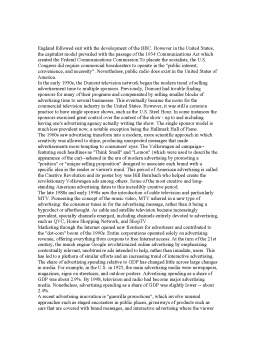Extras din referat
Advertising is paid and/or sometimes free communication through a medium in which the sponsor is identified and the message is controlled. Variations include publicity, public relations, product placement, sponsorship, underwriting, and sales promotion. Every major medium is used to deliver these messages, including television, radio, movies, magazines, newspapers, the Internet, and billboards. Advertisements can also be seen on the seats of grocery carts, on the walls of an airport walkway, on the sides of buses, heard in telephone hold messages and in-store PA systems. Advertisements are usually placed anywhere an audience can easily and/or frequently access visuals and/or audio, especially on clothing.
Advertising clients are predominantly, but not exclusively, for-profit corporations seeking to increase demand for their products or services. Some organizations that frequently spend large sums of money on advertising but do not strictly sell a product or service to the general public include: political parties, interest groups, religion-supporting organisations, and militaries looking for new recruits. Additionally, some non-profit organizations are not typical advertising clients and rely upon free channels, such as public service announcements. For instance, a well-known exception to the use of commercial advertisements is Krispy Kreme doughnuts which relies on word-of-mouth.
The advertising industry is large and growing. In the United States alone in 2005, spending on advertising reached $144.32 billion, reported TNS Media Intelligence. That same year, according to a report titled Global Entertainment and Media Outlook: 2006-2010 issued by global accounting firm PricewaterhouseCoopers, worldwide advertising spending was $385 billion. The accounting firm's report projected worldwide advertisement spending to exceed half-a-trillion dollars by 2010.
While advertising can be seen as necessary for economic growth, it is not without social costs. Unsolicited Commercial Email and other forms of spam have become so prevalent as to have become a major nuisance to users of these services, as well as being a financial burden on internet service providers. Advertising is increasingly invading public spaces, such as schools, which some critics argue is a form of child exploitation. One scholar has argued that advertising is a toxic by-product of industrial society which may bring about the end of life on earth.
History
Commercial messages and political campaign displays have been found in the ruins of ancient Arabia. Egyptians used papyrus to create sales messages and wall posters, while lost-and-found advertising on papyrus was common in Ancient Greece and Ancient Rome. Wall or rock painting for commercial advertising is another manifestation of an ancient advertising form, which is present to this day in many parts of Asia, Africa, and South America.
The tradition of wall painting can be traced back to Indian rock-art paintings that date back to 4000 BCE. As printing developed in the 15th and 16th century, advertising expanded to include handbills. In the 17th century advertisements started to appear in weekly newspapers in England. These early print advertisements were used mainly to promote: books and newspapers, which became increasingly affordable due to the printing press; and medicines, which were increasingly sought after as disease ravaged Europe. However, false advertising and so-called "quack" advertisements became a problem, which ushered in the regulation of advertising content.
As the economy expanded during the 19th century, advertising grew alongside. In the United States of America, classified advertisements became popular, filling pages of newspapers with small print messages promoting various goods. The success of this advertising format eventually led to the growth of mail-order advertising such as the Sears Catalog – at one time referred to as the "Farmer's Bible".
In 1841, the first advertising agency was established by Volney Palmer in Boston. It was also the first agency to charge a commission on ads at 25% commission payed by newspaper publishers to sell space to advertisers. At first, agencies were brokers for advertisement space in newspapers. N.W. Ayer & Son was the first full-service agency to assume responsibility for advertising content. N.W. Ayer opened in 1875, and was located in Philadelphia.
At the turn of the century, there were few career choices for women in business; however, advertising was one of the few. Since women were responsible for most of the purchasing done in their household, advertisers and agencies recognised the value of women's insight during the creative process. In fact, the first American advertising to use a sexual sell was created by a woman – for a soap product. Although tame by today's standards, the advertisement featured a couple with the message "The skin you love to touch".
When radio stations began broadcasting in the early 1920s, the programs were aired without advertisements. This was so because the first radio stations were established by radio equipment manufacturers and retailers who offered programs in order to sell more radios to consumers. As time passed, many non-profit organisations followed suit in setting up their own radio stations, and included: schools, clubs and civic groups.When the practice of sponsoring programs was popularised, each individual radio program was usually sponsored by a single business in exchange for a brief mention of the business' name at the beginning and end of the sponsored shows. However, radio station owners soon realised they could earn more money by selling sponsorship rights in small time allocations to multiple businesses throughout their radio station's broadcasts, rather than selling the sponsorship rights to single businesses per show. This practice was carried over to television in the late 1940s and early 1950s.
A fierce battle was fought between those seeking to commercialise the radio and people who argued that the radio spectrum should be considered a part of the commons – to be used only non-commercially and for the public good. In Canada, advocates like Graham Spry were able to convince the federal government to adopt a socialist funding model.
Preview document
Conținut arhivă zip
- Advertising.doc

















